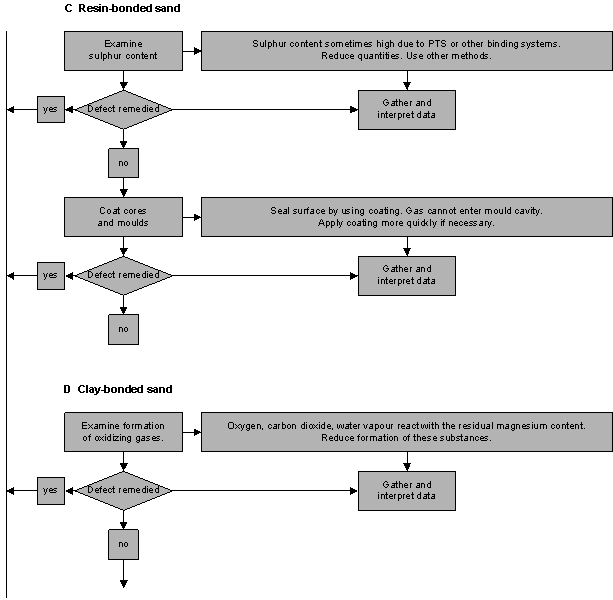 |
| Add caption |
Wednesday, May 29, 2013
Monday, May 27, 2013
Pitted surfaces |
| Characteristic features Formation of craters on castings of SG cast iron, particularly at very hot sections. Can appear individually but also extensively. Graphite degeneration occurs beneath the crater.
Incidence of the defect
The defect occurs exclusively in SG iron castings when poured into bentonite-bonded sand, predominantly at the positions in the sand which are subjected to high thermal loading.
Explanations
The defect occurs only in the presence of fluorides, which are either introduced into the sand through exothermic feeders or are used for the treatment of the melt. Since oxide formation and graphite degeneration are typical characteristics in the deeper parts of the pits and craters, an oxidizing influence can be assumed.
In our opinion, fluorides destroy the protective magnesium oxide layer on the surface of the molten iron. Water vapour from the green sand mould then reacts on the surface with the residual magnesium content of the melt.
Possible causes
Clay-bonded sand
Metallurgical Remedies Clay-bonded sand
Gating and pouring practice
Background information The defect is barely mentioned in literature, the mechanism is unknown outside our company. The single reference describes the increased susceptibility of SG cast iron with a high silicon content (3%) (1). Since the actual defect is caused by the reaction of water vapour with the residual magnesium content of the melt after the protective oxide layer has been destroyed by fluorides, any action which reduces the fluoride and water content in the moulding sand will be effective. Feeders In order to achieve the reaction 4 Al+ 3 O2 -> 2 Al2O3all exothermic feeders contain fluorides which destroy the aluminium oxide layer on the aluminium powder. Depending on the binder, the aluminium used and the oxidant, it is possible to work with different amounts of fluoride. The user should know the fluoride content of the feeder.
There is also the option of using sodium silicate-bonded feeder sleeves which adhere to the metal feeder and are removed with it. However, it should be noted that the fluoride content in sodium silicate-bonded feeder sleeves is normally higher but it is often possible to use insulating sleeves that are free of fluoride.
Moulding sand The higher the water content in the moulding sand, the faster can a reaction with the surface of an SG iron casting occur when a critical fluoride content is exceeded.
All measures for reducing the water content and, above all for reducing the bentonite content, are effective. Here, reference is made to the use of bentonite with a high montmorillonite content and a high cohesive capacity. In addition, improved bentonite development will result in a reduction in crater formation.
The use of carbon carriers with a high capacity for forming lustrous carbon also leads to a reduction of crater formation. Reduction of the water content in the moulding sand as well as suppression of water vapour from the mould cavity could also play a part.
References [1] Labbé, D.; Arliguie, J.-P. Eigentümlicher Oberflächenfehler an Gußstücken aus Gußeisen mit Kugelgraphit Fonderie, Fondeur aujourd'hui 1985, S. 33-34 (franz.)
|
Thursday, May 16, 2013
metal casting
Pengertian Pengecoran
A. Mengenal Proses Pengecoran Logam
1. Pengertian
Pengecoran (casting)
adalah suatu proses penuangan materi cair seperti logam atau plastik
yang dimasukkan ke dalam cetakan, kemudian dibiarkan membeku di dalam
cetakan tersebut, dan kemudian dikeluarkan atau dipecah-pecah untuk
dijadikan komponen mesin. Pengecoran digunakan untuk membuat bagian
mesin dengan bentuk yang kompleks.
Pengecoran
digunakan untuk membentuk logam dalam kondisi panas sesuai dengan
bentuk cetakan yang telah dibuat. Pengecoran dapat berupa material logam
cair atau plastik yang bisa meleleh (termoplastik), juga material yang
terlarut air misalnya beton atau gips, dan materi lain yang dapat
menjadi cair atau pasta ketika dalam kondisi basah seperti tanah liat,
dan lain-lain yang jika dalam kondisi kering akan berubah menjadi keras
dalam cetakan, dan terbakar dalam perapian. Proses pengecoran dibagi
menjadi dua, yaitu : expandable (dapat diperluas) dan non expandable (tidak dapat diperluas).
Subscribe to:
Comments (Atom)











